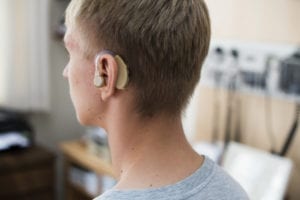Luckily, hearing aids can help alleviate some of these communication difficulties, and help people to hear and understand conversation and the world around them. Unfortunately, out of the estimated 30 million people that have a hearing loss that impacts their communication, only 20% of these individuals use hearing aids!
Hearing aids are electronic devices worn over or in the ear that manipulate and process sounds to make it easier to understand speech and improve sound awareness. Research has shown that using hearing aids is associated with significant improvements in social, emotional, psychological, and even physical health. Using hearing aids has even shown increased earning power and satisfaction in the workplace due to improved hearing and communication. So, why do so few people with hearing loss use hearing aids?
First, people can be so bombarded by daily mailings and ads promoting different devices, that it can be difficult to decide where to seek help. Consumer Reports and AARP report that the best places to seek hearing healthcare is from a licensed audiologist who works with an ear, nose and throat physician. Not one person experiences hearing loss the same way. An audiologist holds a masters or a doctorate degree in hearing healthcare, and can further explain your hearing loss and what you may be experiencing, as well as discuss your communication needs and goals to help choose a device that will work for you. They also must keep current with new hearing aid technology and techniques for getting the most out of them.
People also tend to have misconceptions about how hearing aids look, and work. They are no longer the hearing aids of your grandfather’s time. The same technology for computers that have allowed them to become smaller and more sophisticated has done the same for modern hearing aids.
Hearing aids are more than just amplifiers – they are sound processors. They are digitally programmed to your individual hearing and needs following an exam and only enhance the areas of hearing where you need extra help. They can also now be controlled better for quiet, medium and loud sounds. Quiet sounds will still sound quiet but are audible, and loud sounds will certainly still be loud, but not uncomfortable.
In addition, the newer hearing aids are much better at handling feedback (whistling) and background noise, which means that it’s easier to hear and understand in busy social situations without becoming overwhelmed. New hearing aids are lighter and more comfortable to wear and are available in a variety of different sizes and colors to suit your preferences.
This is only a fraction of what’s new in hearing aids. The best way to learn about what they can do for you is to speak with an audiologist and experience the process yourself. Your audiologist will tailor recommendations based on your hearing exam and your lifestyle to make sure you are receiving the best benefit. Now that you know some of your options, there’s no reason to miss out!
At Advanced Audiology & Hearing Aids Services, we diagnose and treat patients of all ages. If you having trouble hearing, visit us at one of our offices in Fairfield County Connecticut in Danbury, New Milford, Norwalk and Ridgefield.
– Melissa Tatton Lev, Au.D. F-AAA

